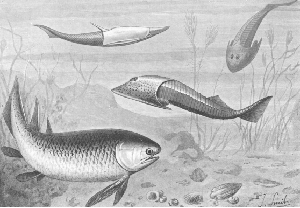After a frigid beginning that exterminated more than half of all marine species, the Silurian oceans gradually warmed and expanded into a laboratory for strange new animals -- such as the six-foot scorpions that inhabited the shallow waters flooding Tennessee 450 million years ago.
Also present was a new a kind of swimmer with scales, fins and backbone -- primitive, boxlike fishes that sluggishly explored estuaries where the first vascular plants tested life on the water's edge. Stalky and leafless, only a few feet tall and crawling with tiny millipedes, this thin perimeter of scraggly shrubs challenged the barren supercontinent of Gondwana -- pioneers that would one day develop into the vast oxygen-generating forests of the Carboniferous (Mississippian) period.
If you visit Silurian rocks exposed in the near Perryville Tennessee, you will find the landscape today is lush with trees and animals. But fossils in the rocks of the Brownsport formation link us to a strange, forgotten time when our world appeared almost lifeless.
During this period, a few brief extinction events fell like hammer blows sculpting the early development of life -- including the mysterious Lau event that wiped out most of the conodonts that flourished during the Ordovician.
As Silurian life surged to its crescendo, the first fish with true jaws appeared, an evolutionary bombshell that would explosively transform our oceans as they crossed over into the Devonian period -- the age of Fishes. |
 Eurypterus, a six foot sea scorpion Eurypterus, a six foot sea scorpion
 Silurian and Devonian Formations in Tennessee. Click to Enlarge Silurian and Devonian Formations in Tennessee. Click to Enlarge
 Primitive fish of the Silurian Primitive fish of the Silurian
|